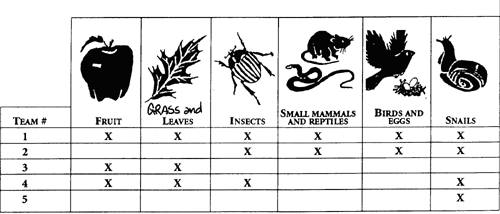Activities for the Classroom
Teachers, please note.
We have two games for your students:
- The Web of Life Pyramid
- The objective of this game is to help primary school children visualize the Himalayan web of life, and why each element is important. Snow Leopard Conservancy uses this game throughout northern India and Nepal in its education programs. The game can easily be adapted to other locations by substituting indigenous animals for those specific to the Himalaya.
- Materials: Box cut-outs printed or photocopied on card-stock paper. (See the pdf file)
- Cut out each element of the pyramid and fold to form a block. The three tabs should be tucked and pasted or taped inside the block to make it solid. Build a pyramid out of the 21 paper blocks, following the graphic below. Each block respresents many (one flower represents all the flowers, for example) and everything together constitutes the mountain ecosystem. The top block always shows people. Remove any block below the people, and see what happens. If you remove any element the whole system collapses.
- Rare Scare
- The objective of this game is to define “endangered”, “threatened”, and “extinct”, and to introduce intermediate students to characteristics that make an animal extremely susceptible to extinction.
- Materials: index cards or paper, markers, easel paper, chalkboard or whiteboard, “rare” animal chart
- Rhinoceroses, pandas, snow leopards, and many other endangered species have more in common than just their endangered status. Many share characteristics that make them extremely susceptible to becoming extinct. Start off the activity by passing out a copy of the “rare” animal chart (See the pdf file) to each person. Explain that each of these animals is imaginary, but each has characteristics that are similar to those of real animals living today. Have the kids read the information given for each animal, then have them decide which of the animals would be the first to become extinct as more and more people move into the area where each animal lives.
- After each person has picked an animal, take a tally to see how many kids voted for each animal. Ask the kids why they picked these animals. Then explain that many animals that are threatened or endangered share one or more characteristics that make them more prone to extinction. Discuss some of these characteristics, using the information below. After the discussion, have the kids look at the “rare” animal chart again to see if they agree with their original choices. Then take another tally and compare the results to those of the first one.
- Explain that the crested crabbit is the animal that will probably become extinct first because it has so many of the characteristics that make an animal susceptible to extinction. For example, it has a very limited range, has a low birth rate, has a very specialized diet, migrates and nests in only one type of tree. Explain that animals that have one or more of these characteristics usually do fine until people-related problems, such as habitat loss and pollution, start to affect them.
- Animals are more prone to extinction if they...
- ..interfere in some way with poeple’s activities: Explain that some animals may kill livestock, eat or ruin crops, or feed on animals that people also like to eat. And because they interfere with people s activities, these animals are often shot, poisoned, or harmed in some other way. Ask the kids if they can think of some examples (many predators, such as eagles, wolves, snow leopards, and tigers as well as geese, ducks, and other birds that sometimes eat crops).
- ...migrate: Animals that migrate usually depend on several different habitat areas. Because of this, they can be very vulnerable to habitat destruction. For example, many songbirds that migrate to tropical forests in winter are in trouble because thousands of acres of their rain forest habitat have been developed into pastures, farms, towns, and roads.
- ...have very specific food or nesting requirements: Some animals are very “picky” about what they eat or where they live, or both. These specialized animals, which are often adapted to eating only one type of food or living in only one type of area, can become endangered if their food source or nesting site disappears. For example, the Delmarva fox squirrel once thrived in the open forests that grew along the Eastern Shore of the states of Maryland, Virginia, and Delaware in the United States. As more and more of these forests disappeared, so did the squirrels. And today the Delmarva fox squirrel is listed as an endangered species.
- ...are very sensitive to changes: Many animals have a very difficult time adapting to changes in their environment. For example, birds of prey and many other animals are very sensitive to chemical changes in their environment, such as the introduction of pesticides. Other animals have a hard time competing with introduced species that have the same nesting or food requirements. For example, bluebirds – a species native to North America – have a hard time competing for nesting sites with starlings, which were introduced from Europe in the early 1900s.
- ...have small broods and long gestation periods: Ask the kids if they can think of some animals that give birth to only one or two young every year or every two or three years (elephants, bats, condors, and so on). Explain that when the populations of these animals drop, it takes much more time for their populations to recover because of the low birth rate. And the animals sometimes become extinct before they have time to make a comeback.
- ...are naturally rare: Some animals are rare throughout their range, and others have a very limited range. In both cases, the animals are often vulnerable to habitat destruction and other people-caused problems. For example, many of the native plants and animals that live on the islands of Hawaii are naturally rare. And as more people move into the area, many of these already rare plants and animals face habitat loss, competition from introduced species, new diseases, and other problems.
- Animals with low birth rates have another problem, too: They don’t reproduce fast enough to produce offspring that can adapt to changing conditions. Have the kids compare the reproductive capabilities of an elephant with those of a cockroach. Explain that on the average, an elephant has about three young every 10 years and that a cockroach has 80 young every half year. Copy the following figures on the board and explain that if all the animals lived and mated, here’s the number of young produced in each generation. (Note: These figures are simplified and represent approximate numbers of individuals per generation).
-
Elephant Cockroach 3 1st Generation 80 6 2nd Generation 3,362 13 3rd Generation 137,842 28 4th Generation 5,651,522 61 5th Generation 231,712,403 132 6th Generation 9,500,208,482 - Ask the kids to compare the number of years it takes an elephant and a cockroach to produce a 6th generation. (Since an elephant has an average of 3 young every 10 years, and a cockroach has an average of 80 young every half year, it would take elephants 60 years to produce 6 generations, and only 3 years for the cockroaches to do the same.) Emphasize that because of their high birth rate, cockroaches have more opportunities to adapt to changes in their environment.

Branching Out: “Picky Eaters”
To demonstrate why specialized animals are often more susceptible to extinction, play this action game outside. Before starting, make a set of food cards by drawing the symbols and words, shown in the chart below, on index cards. For a group of 30 kids, you should make 10 fruit, 15 leaves, 15 insects, 10 small mammals and reptiles, 10 birds and eggs, and 10 snails.
Also copy the chart on a chalkboard or piece of easel paper so the kids can see which symbol stands for which food items and which foods each team eats. Before going outside, divide the group into five teams and give each team a number. Then tell them to look at the chart to see what they eat. For example, the kids in Team #1 are animals that eat fruit, leaves, insects, small mammals and reptiles, birds and eggs, and snails. And the kids in Team #2 are animals that feed on insects, small mammals and reptiles, eggs, and snails.
Now go outside and spread the food cards in a large playing area. (It’s a good idea to play this game on non-windy days, or have stones ready to hold the papers down.) Remind the kids what each team can eat and what each card represents. Then have the kids form a huge circle around the playing area. When you say “go,” have the kids get down on their hands and knees and crawl around the playing circle to find food. (If the ground is wet or muddy, have the kids hop instead of crawl.) Tell them to collect as many food cards as they can find, but that they should collect only the type of food they can eat. For example, the kids in team #4 would be able to collect only insects, leaves, and fruit.
After all the cards have been collected, have the kids count how many they have. Explain that to survive, each animal needs at least two food cards. How many animals didn’t find enough food?
Now play again, but explain that people have destroyed much of the habitat in the area to build an airport, shopping center, or houses. Take away five of each type of food card and scatter the cards again. Which animals survived the second time? Ask the kids which animals had the hardest time surviving and why. (The animals in team #5 probably had the hardest time because they had the most specialized diet and when their food source became depleted, they would have starved. The non-specialized eaters, on the other hand, could eat another type of food when one of their food sources became depleted.) Finally, point out other examples of animals living in your area that have very specialized food or nesting requirements.

This activity is found in Environmental Education in the Schools: Creating a Program that Works!, by Judy A. Braus and David Wood, U.S. Peace Corps Information Collection and Exchange, August 1993.
